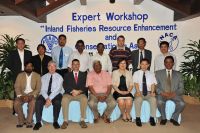Inland Fisheries Resource Enhancement and Conservation in India
2 July 2010 | V.V. Sugunan | 5055 views | .mp3 | 4.84 MB | Genetics and Biodiversity, India, Stock enhancement
India produces 4.6 million tonnes of fish annually from its inland water bodies, of which 1 million tonnes originates from enhancement and capture fisheries of open waters. It is estimated that 1.5 million ha of small reservoirs are amenable for culture-based fisheries and 1.7 million ha of medium and large reservoirs can be developed on the basis of enhanced capture fisheries.
Reservoirs of all categories together produce 94,000 tonnes of fish against a potential of nearly 1 million tonne. Wetlands situated at the floodplains, commonly called beels (300,000 ha) form an important resource for practising enhancement. Reservoirs and wetlands are stocked mainly with the Indian major carps for culture-based fisheries and enhanced capture fisheries. Sufficient numbers of fish fingerlings are not produced in the country to meet all stocking requirements. Species enhancement, though tried with tilapia, common carp and silver carp, has not been very successful. Instances of environmental enhancement and enhancement through cage and pen culture are not very popular either. River stocking attempts made so far are sporadic with very little impact.
Inland waters of India harbour a rich fish biodiversity supporting capture fisheries in rivers, estuaries, lagoons, upland lakes and mangroves. Decline of fish populations in rivers is due to a variety of factors including habitat loss, effluent discharge, water abstraction, and dams and hydraulic structures, besides other socio-legal reasons. Many initiatives have been taken by the government to conserve the biodiversity that include in-situ conservation, ranching, fish sperm and embryos cryopreservation, tissue banking, live gene banks and provision of fish passes. Government of India has enacted National Biodiversity Action Plan in 2008 and created a National Biodiversity Board.
Ownership of inland water bodies other than small ponds vests with the government and the fishing rights of reservoirs and beels are given to individuals, groups and communities according to norms that vary across the states. Rivers are generally fished as a common pool resource with free access, except in a very few States that auction river stretches to individuals. The institutional, policy, legislative and financial environments under which enhancement and capture fisheries regimes exist are not conducive to the interests of the fishers. Strong tools for valuation of ecosystem goods and services, enabling governance arrangements and estimation of environmental flows are needed. Fishing communities need to be organized into strong co-management/participatory/community regimes in order to ensure that all stakeholders take part in decision making process and the benefits accrued are shared equitably by all.
Creative Commons Attribution.
